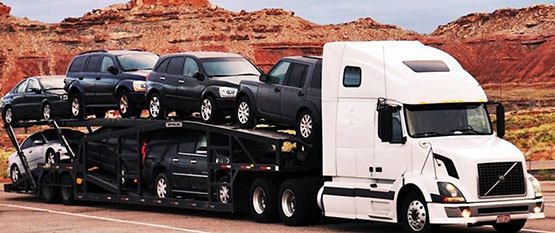The 7 Factors that Determine Car Shipping Costs
Many people who look for the cheapest car shipping option ask “How much does it cost to ship a car” then obtain 3 or 4 auto transport quotes from various car shipping companies. It’s common to see a couple of quotes clustered in the middle, and one or two that vary by several hundred dollars. Knowing how car transport costs are determined and what the average cost is, enables you to spot any deal that might be too-good-to-be-true, avoiding potential surprises. So, what are the main factors that drive car transport costs and how to choose the best option for shipping? Ideally you want to utilize the cheapest way. Sometimes that means a terminal Shipping. Is this right for you? Lets explore all the cost that going into getting you the cheapest way to receive your car:
1. Distance
Miles are the starting point, of course – though they are not as proportional with longer distances as you might imagine. That’s because shorter distances require the same effort in pick-up & drop-off by the driver, even though the Carrier spends less time actually “on the road”. This is why the average cost of long-distance shipping can actually be cheaper per mile, just as an airline ticket may cost more per mile going half way across the country versus going coast to coast.
2. Open trailer or Enclosed carrier?
The type of transport you choose is a leading factor in price. The more common method of shipping, an open trailer, is typically the double-decker type seen every few miles on America’s highways, loaded with 7-10 cars on long-haul trips. On shorter routes, 3-4 car trailers do a great job too. 75% of customers find open car transport shipping with 3 – 10 cars the most cost-effective method, which is why it’s the most popular way to go. Think of it like flying “coach class” versus “first class”.
Enclosed transport trailers are smaller, with a capacity of just 2-6 vehicles. Since it takes the same number of days and miles (labor cost and gasoline) for a Carrier to drive from point A to point B while getting paid for fewer vehicles, enclosed auto shipping typically costs 40% - 60% more than transporting the same vehicle on an open trailer.
♦ Insider Tip: While enclosed transport typically offers a higher level of service, unless your car is a luxury vehicle, exotic car, or a classic valued at more than $70,000 you are likely to be just as satisfied with the more budget-conscious option of open transport.
3. Your Vehicle Type, Size & Modifications
These are important factors when shipping a vehicle because trailers have maximum loads for safety. When looking for a quote, we ask what type of vehicle you're shipping such as a small SUV or maybe your shipping several
four-door sedans and the model of the car so we can ensure an accurate quote for you and the trucker. Heavy vehicles, like a truck or large and small SUV, use up more of that maximum-allowable weight load – which means the trailer may be limited on the number of other vehicles it could carry. Similarly, a longer-than-average vehicle takes up more than 1 space on a trailer. So, a Carrier transporting a 7000 pound Ford F-350 Crew Cab Long Bed would need to offset that with a shorter, light-weight vehicle size like a VW Beetle or such, to optimize space on the trailer . . . if a smaller vehicle is readily available on that route at that exact time versus other larger vehicles. Otherwise, the Carrier might need to depart on time with less than a full load: a factor that goes into the price of transporting a vehicle with above-average weight, height, length or other post-factory modifications like special equipment. Keep in mind, personal belongings cannot be shipped inside the car - which would ultimately affect the weight of your vehicle. So be sure to take out all items from the car before giving it to the driver.
4. Condition of Vehicle: Running, or Not?
A car that doesn’t run or start on its own is called “inoperable”, and requires extra time, effort and equipment from the Carrier. The truck driver needs additional incentive to accept a vehicle that he will need to push, pull, winch, jump-start or otherwise skillfully maneuver on and off the truck. He may even need to do so more than once during the course of a shipment, depending on the position of other vehicles already on the trailer ahead of it, which may need to be off-loaded in reverse order.
♦ Insider Tip: The average industry surcharge for an inoperable vehicle is $150. If it seems you’re being charged more, which you can check against the auto-quote of any top-tier auto transport company by changing the selection from “inoperable” to “runs”, don’t hesitate to question pricing.
5. Popularity of the Route
Pick-up and/or Drop-offs in rural areas cost more than to and from major cities and metropolitan areas. Larger cities simply have more Carriers that regularly service the area, and there are more major highways for easier access by drivers. Just as there are more flights each day than from NY to Los Angeles than there are from Kansas City to Reno, there are similarly more trucks available in urban areas. This is why it’s easier, and often faster, to get the best rates for door to door shipping on widely-travelled routes.
♦ Insider Tip: If you live in an area that’s more challenging for trucks to access – let’s say the mountains of Taos, New Mexico or the coast of Big Sur, CA – consider whether you have the flexibility to meet the Carrier at a rest stop along a major highway instead of direct door to door service. While you’ll need to be comfortable with leaving the timing a little looser until the driver is approaching your vicinity, some customers who live in hard-to-access locations find the cost savings to be worth the trade-off.
6. Season of Year
High demand during key seasons can cause prices to spike on some routes, since even Carrier drivers need holidays. For example, shipping a car before Thanksgiving or Christmas can be challenging to book, and costlier to arrange. Actually, this applies to all major holidays: New Year’s, Memorial Day, July 4th, Labor Day, and even Valentine’s Day. In certain parts of the country, hurricane season or occasional floods in Florida, Texas, the Carolinas can affect availability and cost as well.
♦ Insider Tip: Did you know the “direction” of car shipments can impact quotes? Just as it’s a lot cheaper to ship goods TO China on a relatively empty container-ship returning home after dropping goods off at a U.S. port, sometimes trailers are fully loaded in one direction, but less on their return route. For example, today there are many more families shipping a vehicle out of California, to Texas or Arizona, than into CA. Or consider that demand during “snowbird season” for car shipments FROM New York and other northern states, down to Florida and other southern states, peaks in October-December. Similarly, booking a vehicle shipment back home on specific dates during the months of March-May can be a challenge. During such peak times, pickup trucks are accustomed to getting incentive-pay to prioritize certain pickups, and prices are higher due to sheer demand – just as air travel costs more during peak travel seasons. So if you can be flexible on your pick-up or drop-off week, beyond the typical lead-time to ship a car, you will experience greater satisfaction levels as well as more affordable pricing.
7. Dates / Speed of Delivery
Express auto shipping costs about 30% more than standard car delivery with door-to-door service. A company that offers expedited or express shipping typically guarantees your choice of (1) a precise Pick-up Date, (2) an exact Drop-off Date, or (3) a guaranteed interval of “x days” from Pick-up to Drop-off.
♦ Insider Tip: When you pay a premium for Express shipping, request a written guarantee on what reimbursement you can expect if by any chance your auto transport company doesn’t meet that date. At a minimum, you should expect a refund on the difference between what you paid, vs. the “base price” for standard auto shipping which a Transport Broker should also inform you about at the time of booking. As an extra measure of good will, a top-tier auto transport company also stands behind its express car shipping guarantee with a credit against your base price. A discount of 10% of the base car shipping cost, or up to about $100, is a reasonable expectation.
Why do car shipping quotes seem to vary widely?
When you're shopping around for the cheapest car shipping option, you'll notice vehicle shipping quotes from different shippers are most likely to vary. Even on the same route, based on the quality of the trailer and the driver – that is, the cost paid to the Carrier for your specific load. Assuming you’re definitely comparing apples-to-apples, especially in terms of "Open vs. Enclosed trailer", the biggest reason for cost differences is what your Transport Broker truly expects will happen behind the scenes about meeting your timeline – and the quality of the Carriers (the actual drivers and trucks) the auto transport company plans to dispatch for your pickup. Many car transport companies offer a low quote without mentioning that you will actually be on a "standby" basis. And if you’ve ever flown standby, you know what that’s like.
In other words, to lock in your business, some Brokers provide you with a car shipping quote that are quite low – in fact, too low to actually succeed in getting your vehicle picked up in the time-frame you requested by a fully-insured and well-qualified, highly-rated Carrier. Some car transport companies hold out to pay the lowest price possible to the Carrier, and as a result get lower-quality trucks and drivers willing to go to your pickup location. Alternatively, they may come back to you after a week of not being able to lock in a Carrier, and tell you they were unable to secure a spot at the price previously quoted. You might then hear, "So if you still want a pickup on the date you selected, it will cost $xxx more". Additionally some brokers are actually quoting you a terminal shipping. Although this may seem the cheapest way, dropping off your vehicle at a terminal can add extra costs to your move and delay the process.
♦ Insider Tip: Choose a Transport Broker that offers an all-inclusive quote that’s guaranteed in writing for at least 10-14 days. They should also specify that insurance is included, and that there are no taxes, fuel-surcharges or other hidden costs. The mark of a solid Transport Broker is a willingness to stand behind the car shipping quote you receive even if gas or labor prices increase in the meantime. If they tell you costs have gone up since the 1st quote, find someone else.
The idea that "you get what you pay for" applies in the vehicle shipping industry, as elsewhere. So it’s wise to ask a few questions about a quote that seems too good to be true. If you obtain several, one idea is to toss out the lowest – and sometimes the highest. Check out FMCSA recommendations and confirm that the company’s license is prominently displayed on their website – along with car shipping reviews. And feel free to ask about their accident claims rate, which should be well under 1.0% of annual car transports.
Then, relax. Don’t sweat the details.
There are tens of thousands of vehicles being shipped every single day across the United States, and virtually all of them arrive without a single incident or major surprise. So if you’ve chosen a reliable car shipping company, you can expect both full coverage and great service.









